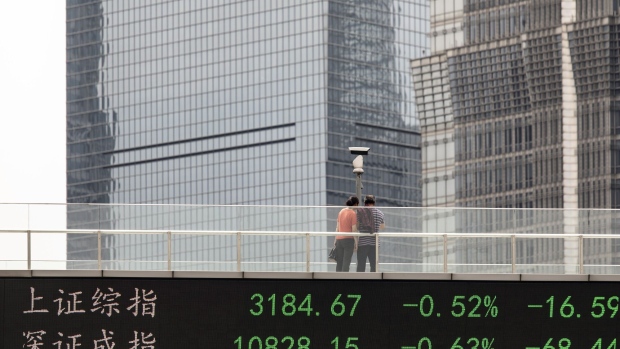Sep 20, 2023
MSCI’s China Gauge Set for 10-Month Low as Pessimism Persists
, Bloomberg News

(Bloomberg) -- Chinese stocks extended their poor run on Thursday, pushing a key gauge to its lowest since November, as an exodus of foreign funds continued amid persistent concerns about the economy.
The MSCI China Index dropped as much as 1.6%, on track for a third consecutive week of losses. The Hang Seng Index and a gauge of major Chinese firms listed in Hong Kong also fell more than 1%. The onshore yuan weakened as much as 0.2%.
The selloff is yet another indication that Beijing’s efforts to restore market confidence are falling flat with investors. Just Wednesday, China’s central bank vowed to use various tools to keep liquidity reasonably ample, adding to a series of steps from policymakers in recent weeks — including a reduction in transaction costs for stock trading and some restrictions on stake sales by top shareholders.
Hedge funds have boosted their bearish bets on Chinese and Hong Kong stocks, with short interest rising this month pretty much across sectors, according to data compiled by Morgan Stanley. Thursday’s declines came amid a broader risk-off mood in global equity markets after the Federal Reserve signaled interest rates will be higher for longer.
“There are still overhangs, such as the prospect of a persistently hawkish Fed and the possibility of a hard landing in the fallout from the property sector, which could keep sentiment low,” said Wu Xianfeng, a fund manager at Shenzhen Longteng Assets Management Co. “One way we might be able to see a turnaround is if the state starts a new round of buying with a market stability fund.”
As worries about the property sector and the economy continue to dominate, net foreign outflows from onshore Chinese stocks are showing no sign of stopping. Global funds have sold 27 billion yuan ($3.8 billion) so far this month via trading links with Hong Kong, after a record 90 billion yuan selloff in August.
READ: A $188 Billion Exodus Shows China’s Heft Fading in World Markets
The CSI 300 Index, benchmark of mainland shares, closed down 0.9%. The gauge is down more than 5% this year, after tumbling 22% in 2022. Turnover in Shanghai and Shenzhen plunged to the lowest since October on Wednesday.
This indicates that nearly two months after authorities pledged to “invigorate capital markets and boost investor confidence,” traders are not biting.
In the offshore market, Hong Kong-listed companies are stepping up share buybacks in a bid to lift valuations, while China’s biggest companies are set to pay out record dividends of 1.5 trillion yuan this year to revive sentiment sapped by an exodus of overseas investors.
The onshore yuan fell even as the central bank set the daily reference rate for the currency at the strongest deviation from market estimates on Thursday.
Chinese firms’ offshore junk dollar bonds - a space dominated by real estate developers - were little changed, according to credit traders. Bond investors remain wary of the nation’s property woes despite the latest easing of home-purchase restrictions in Guangzhou, with a dollar note of Longfor Holdings Ltd. dropping for a third straight day.
An Bloomberg Intelligence equity gauge of real estate companies fell 0.8% in its sixth straight session of declines.
READ: China Property’s Fading Rebound Deepens Pessimism: Taking Stock
Thursday’s yuan fixing at the strongest bias on record showcased PBOC’s consistent efforts to slow the currency’s depreciation, especially ahead of the Asian Games, said Stanley Chan, head of FX trading at Chong Hing Bank. “Economic fundamentals have not changed, the market is still expecting another RRR cut sometime later.”
--With assistance from Iris Ouyang and Dorothy Ma.
©2023 Bloomberg L.P.






